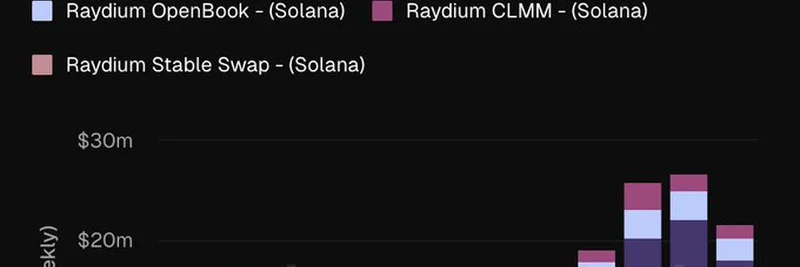If you’ve been keeping an eye on the decentralized finance (DeFi) space, you might have noticed some exciting news from Token Terminal. According to their recent tweet on August 7, 2025, weekly fees for Raydium, a popular automated market maker (AMM) on the Solana blockchain, have skyrocketed by approximately 100% in the past month. This surge, highlighted in a detailed chart, signals a booming activity level that’s worth digging into. Let’s break it down and see what it means for investors and DeFi enthusiasts!
What’s Driving the Fee Surge?
The chart from Token Terminal breaks down the fees into different categories: Raydium LaunchLab, CPMM (Constant Product Market Maker), OpenBook, CLMM (Concentrated Liquidity Market Maker), and Stable Swap. What stands out is the steady climb from early June to early August 2025, with a noticeable spike in the last few weeks.
This growth likely stems from increased trading volume and user engagement on Raydium, which is known for its lightning-fast transactions and innovative features like the AcceleRaytor launchpad. Solana’s high-speed, low-cost blockchain is a perfect fit for such a platform, attracting more users and projects. The rise in fees suggests that more people are swapping tokens, launching new projects, or leveraging Raydium’s unique liquidity pools—all signs of a thriving DeFi ecosystem.
Breaking Down the Chart
Looking at the image, the blue bars representing LaunchLab fees show the most significant jump, indicating a surge in new token launches or initial DEX offerings (IDOs). Meanwhile, CPMM and CLMM fees (in purple and pink) also contribute substantially, reflecting active trading and liquidity provision. The Stable Swap and OpenBook categories, though smaller, add to the overall picture of diversified activity.
By early August, weekly fees have climbed to over $20 million, a stark contrast to the $10 million range seen in June. This doubling is a clear indicator that Raydium is capturing more market share in the Solana DeFi space.
Why Should You Care?
For DeFi practitioners and meme token enthusiasts (yes, we’re looking at you, Meme Insider readers!), this surge is more than just a number. Higher fees often mean higher revenue for the protocol, which could lead to better incentives for liquidity providers and potentially boost the value of RAY, Raydium’s native token. If you’re into yield farming or staking, this could be a golden opportunity to jump in.
Moreover, the growth reflects Solana’s increasing dominance in DeFi. With its low transaction costs and high throughput, Solana is becoming a go-to blockchain for projects and traders alike. Raydium’s success could also spill over into the meme coin craze, as new tokens launched via AcceleRaytor might catch the community’s attention.
What’s Next for Raydium and Solana?
While the data is promising, it’s worth keeping an eye on whether this growth is sustainable. Factors like market conditions, new competitors, or changes in Solana’s network performance could influence future trends. For now, the 100% fee increase is a bullish signal, suggesting that Raydium and Solana are riding a wave of adoption.
If you’re a blockchain practitioner looking to stay ahead, consider exploring Raydium’s dashboard to track these changes in real-time. Whether you’re investing, trading, or just curious about the next big meme token, understanding these shifts can give you an edge.
Final Thoughts
The Raydium fee surge is a exciting development in the DeFi world, showcasing the power of Solana’s infrastructure and Raydium’s innovative approach. As we move forward, it’ll be fascinating to see how this impacts the broader crypto landscape, especially for meme token enthusiasts. Stay tuned to Meme Insider for more updates and insights into this evolving space!
Got questions about Raydium or Solana? Drop them in the comments, and let’s dive deeper!

